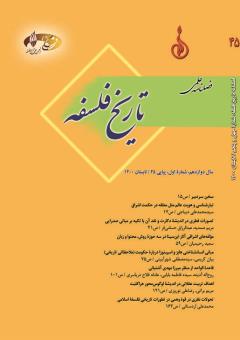تبارشناسی و هویت عالم مثل معلقه در حکمت اشراق
محورهای موضوعی : یافتههای نو درباره چهرهها و مدرسههای فلسفی ایران و جهان اسلام
1 - دانشیار گروه فلسفه، پردیس فارابی دانشگاه تهران، قم، ایران
کلید واژه: عالم مثل معلقه, قوة خیال, نفوس فلکی, برزخ, سهروردی,
چکیده مقاله :
نظریة مثل معلقه یکی از مهمترین دیدگاههای فلسفی سهروردی است. دربارة این نظريه پرسشهاي مهمی مطرح است، از جمله اینکه هویت این عالم از نظر سلسله مراتب عوالم هستی، چیست؟ این پرسش در لسان اشراقی بدین صورت مطرح شده که آیا هویت این عالم، نوری است یا ظلمانی یا ترکیبی از ایندو؟ دیگر اینکه، این نظريه با میراث گذشته تفکر اسلامی و حکمت و کلام چه رابطهيي دارد و به اصطلاح تبارشناسی آن، ما را در تاریخ فلسفه، حکمت و کلام به چه دیدگاههايي میرساند؟ یافتههای پژوهش حاضر نشان میدهد که مباحث قوة خیال در فلسفة فارابی، قوة متخیله و نفوس فلکی در حکمت سینوی، عقیده به برزخ در کلام اسلامی و نظریۀ تمثل در عرفان، میراثهای فکری و اعتقادییی هستند که در تبیین این نظريه مؤثر بودهاند. از سوی دیگر، توجه به مبانی و ادلّة سهروردی برای تبیین این نظريه و همچنین درباب هویت عالم مثال، نشان میدهد که موجودات عالم مثل وجهی جمعی دارند و هویت نورانی و ظلمانی، هر دو در آنها هست.
The theory of suspended ideas is one of Suhrawardī’s most important philosophical innovations. Several challenging queries have been ventured regarding this theory; for example, questions have been raised about the identity of this world in the hierarchy of the realms of being. This question, in its Illuminationist sense, has been posed as follows: Is the identity of this world of the type of light, darkness, or a combination of both of them? Another question asks whether this theory is related to the legacy of Islamic philosophy, wisdom, and kalām, and to which views it leads in its genealogical sense in the history of these three disciplines. The findings of the present study indicate that the discussions of the faculty of imagination in Fārābī’s philosophy, imagination and spherical souls in Ibn Sīnā’s philosophy, the belief in Purgatory in Islamic kalām, and the theory of allegory in gnosis are the philosophical and ideological legacies which have influenced the explanation of this theory. On the other hand, resorting to Suhrawardī’s principles and arguments to explain this theory and the identity of the world of Ideas indicates that the existents of the world possess collective modal ideas and both luminous and dark identities.
ابنسينا (1404 ق/ الف) الشفاء، الالهیات، تقدیم ابراهیم مدکور، قم: کتابخانه آیتالله مرعشی.
ابنسينا ( 1404 ق/ ب ) الشفاء، الطبیعیات، النفس، تقدیم ابراهیم مدکور، قم: کتابخانه آیتالله مرعشی.
ابنسينا (1413ق) الاشارات والتنبیهات، تحقیق سلیمان دنیا، ج2و 4، بيروت: مؤسسة نعمان.
ابنعربی، محیالدین (بیتا) فتوحات مکیه، جزء3، قاهره: دارالکتب العربیة الکبری.
اشکوری، قطبالدین (1399) فانوس الخیال فی تحقیق عالم المثال، تحقیق سید محمد علی دیباجی و مصطفی عابدی، قم: دیبانقش.
بهایی لاهیجی، محمدبن محمد (1372) رسالۀ نوریة مثالیه، تصحیح و تعليق سیدجلالالدین آشتیانی، تهران: دفتر مطالعات دینی هنر.
پورجوادی، نصراللّه (1358) سلطان طریقت، تهران: آگاه.
دشتکی شیرازی، غیاثالدین (1382) اشراق هیاکل النور لکشف ظلمات شواکل الغرور، تحقیق علی اوجبی، تهران: میراث مکتوب.
دیباجی، سیدمحمدعلی (1387)، «نبوات در فلسفه ملاصدرا»، قبسات، شمارة 50، ص200ـ181.
دیباجی، سیدمحمدعلی؛ عابدی، مصطفی (1396) «جهانوطنی نوری بمثابه اتوپیای اشراقی»، حکمت و فلسفه، سال13، شمارة3، ص62ـ47.
رضی، هاشم (1380) حکمت خسروانی، تهران: بهجت.
سهروردی، شهابالدین (1373الف) مشارع و مطارحات، در: مجموعه مصنفات شيخاشراق، ج1، تصحیح هانری کربن، تهران: پژوهشگاه علوم انساني و مطالعات فرهنگي.
سهروردی، شهابالدین (1373ب) حکمة الاشراق، در: مجموعه مصنفات شيخاشراق، ج2، تصحیح هانری کربن، تهران: پژوهشگاه علوم انساني و مطالعات فرهنگي.
سهروردی، شهابالدین (1373ج) آواز پر جبرئیل، در: مجموعه مصنفات شيخاشراق، ج3، تصحیح سیدحسین نصر، تهران: پژوهشگاه علوم انساني و مطالعات فرهنگي.
سهروردی، شهابالدین (1373 د) فی حقیقه العشق، در: مجموعه مصنفات شيخاشراق ، ج3، تصحیح سیدحسین نصر، تهران: پژوهشگاه علوم انساني و مطالعات فرهنگي.
سهروردی، شهابالدین (1380) الالواح العمادیه، در: مجموعه مصنفات شيخاشراق، ج4، تصحیح نجفقلی حبیبی، تهران: پژوهشگاه علوم انساني و مطالعات فرهنگي.
شهرزوری، شمسالدین (1380) شرح حکمة الاشراق، تصحیح حسین ضیایی، تهران: پژوهشگاه علوم انساني و مطالعات فرهنگي.
شیرازی، قطبالدین (1391) شرح حکمة الاشراق، تصحیح سیدمحمدموسوی، تهران: حکمت.
عینالقضات همدانی، عبدالله (1373) تمهیدات، تصحیح و مقدمه عفیف عسیران، تهران: منوچهری.
غزالی، احمد (1359) سوانح العشاق، تصحیح و مقدمه نصرالله پورجوادی، تهران: بنیاد فرهنگ ایران.
فارابی، ابونصر (2012) آراء اهل المدینه الفاضله، قاهره: هنداوی.
قاضی عبدالجبار (1408) شرح الاصول الخمسه، مکتبة وهبة.
قیصری، شرفالدین داوود (1370) مقدمه فصوص الحکم، مندرج در شرح بر مقدمه قیصری، سیدجلالالدین آشتیانی، تهران: امیرکبیر.
کربن، هانری (1358) ارض ملکوت، ترجمة سیدضیاءالدین دهشیری، تهران: مرکز مطالعة فرهنگها.
لاهیجی، ملاعبدالرزاق (1383) گوهرمراد، تصحیح و مقدمه زینالعابدین قربانی، تهران: سایه.
ملاصدرا (1410) الحكمة المتعاليه فی الاسفار الاربعه، ج8، بيروت: داراحياء التراث العربي.
موحد، صمد (1384) «مقاله مناسبات میان سهروردی و ابنعربی»، فصلنامه اشراق، شمارة 23، ص39ـ 32.
یزدانپناه، اسدالله؛ علیپور، مهدی (1391) حکمت اشراق، گزارش، شرح و سنجش دستگاه فلسفی سهروردی، تهران: سمت.
